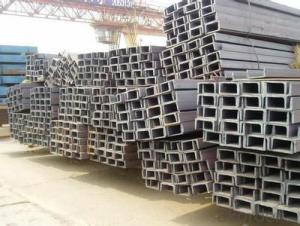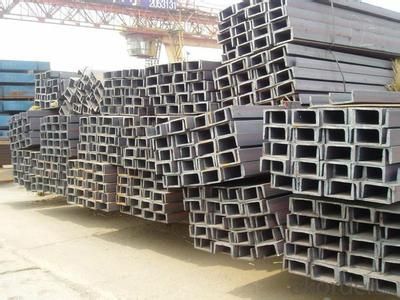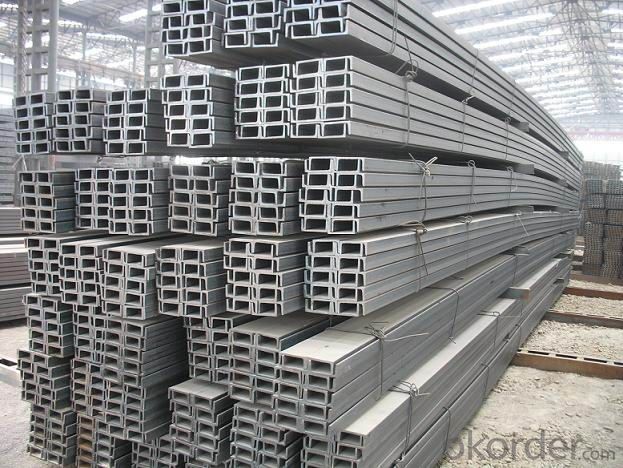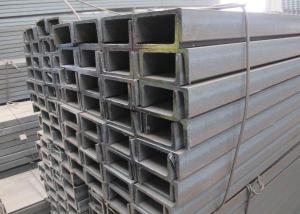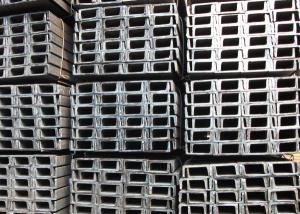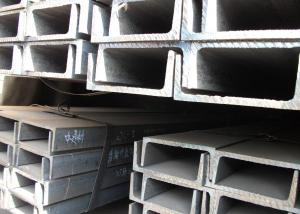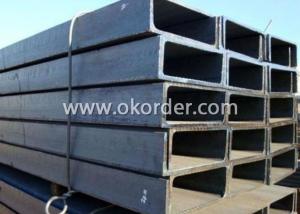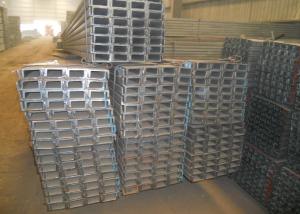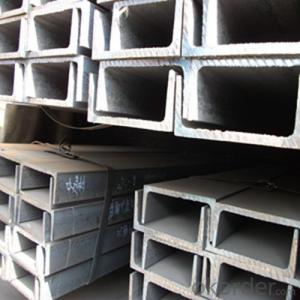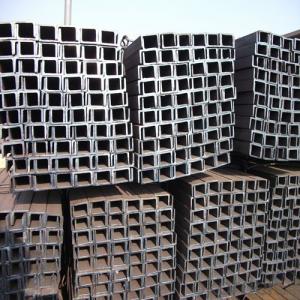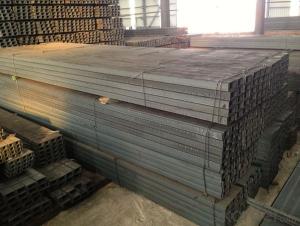Hot Rolled Channel Steel, Channel Bar JIS Standard
- Loading Port:
- Qingdao
- Payment Terms:
- TT OR LC
- Min Order Qty:
- 2000 PCS
- Supply Capability:
- 38000 PCS/month
OKorder Service Pledge
OKorder Financial Service
You Might Also Like
JIS Standard Hot Rolled Channel Steel, Channel Bar Details
| Standard: | BS,DIN,GB,JIS | Dimensions: | 50 mm to 200 mm | Grade: | SS400-SS540;S235JR-S275JR or Equivalent |
| Place of Origin: | China (Mainland) | Brand Name: | CNBM | Shape: | U Channel |
| Application: | applications that require a strong steel framework, like warehouses et | Perforated Or Not: | Not Perforated | Length: | 6-12m |
| Certification:: | SGS,CIQ | Name: | Jis Standard Hot Rolled Channel Steel, channel bar | Carbon: | low carbon |
Packaging & Delivery
| Packaging Detail: | Packing in bundles |
| Delivery Detail: | 30 to 45 days |
JIS Standard Hot Rolled Channel Steel, Channel Bar Specifications
Standard Sectional Dimension (mm) | Web thickness (mm) | Flange thickness (mm) | Weight (kg/m) |
50*25 | 3.00~5.00 | 6.00 | 2.37~3.46 |
75*40 | 3.80 | 7.00 | 5.30 |
75*40 | 4.00 | 7.00 | 5.60 |
75*40 | 4.50 | 7.00 | 5.85 |
75*40 | 5.00 | 7.00 | 6.92 |
100*50 | 3.80 | 6.00 | 7.30 |
100*50 | 4.20 | 6.00 | 8.03 |
100*50 | 4.50 | 7.50 | 8.97 |
100*50 | 5.00 | 7.50 | 9.36 |
125*65 | 5.20 | 6.80 | 11.66 |
125*65 | 5.30 | 6.80 | 12.17 |
125*65 | 5.50 | 8.00 | 12.91 |
125*65 | 6.00 | 8.00 | 13.40 |
150*75 | 5.50 | 7.30 | 14.66 |
150*75 | 5.70 | 10.00 | 16.71 |
150*75 | 6.00 | 10.00 | 17.90 |
150*75 | 6.50 | 10.00 | 18.60 |
200*80 | 7.50 | 11.00 | 24.60 |
200*90 | 8.00 | 13.50 | 30.30 |
250*90 | 9.00 | 13.00 | 34.60 |
JIS Standard Hot Rolled Channel Steel, Channel Bar Pictures
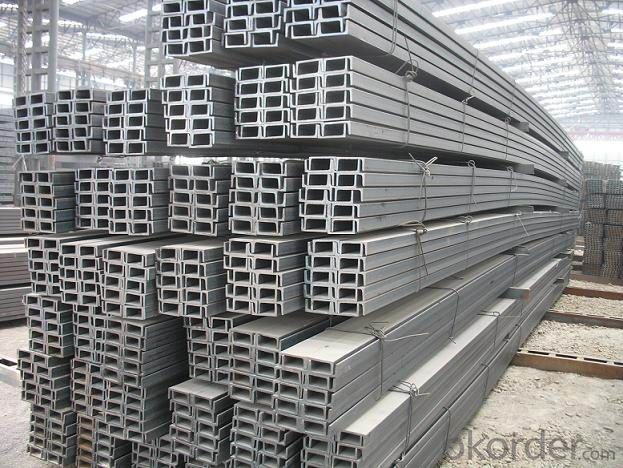
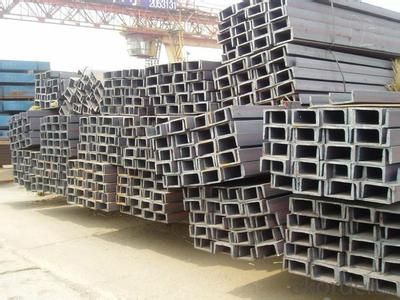
- Q: Are steel channels suitable for use in warehouse storage systems?
- Indeed, warehouse storage systems can make effective use of steel channels. Steel channels offer a robust and enduring structure that can bear the weight of heavy loads within a warehouse. They possess the capability to withstand the pressure generated by diverse storage items, and can be employed in various storage arrangements, including pallet racking systems, shelving units, or mezzanine platforms. Steel channels exhibit resistance to harm, corrosion, and wear, thereby guaranteeing an extended lifespan for the storage system. Moreover, they can be conveniently personalized and altered to suit different storage requirements and configurations, rendering them a flexible option for warehouse storage systems.
- Q: Can steel channels be used for both residential and commercial construction?
- Steel channels are suitable for both residential and commercial construction. These versatile structural components can be utilized in a variety of ways, such as in the construction of building frames, support beams, and walls and ceilings. Due to their strength and stability, they are well-suited for both residential and commercial projects. Furthermore, steel channels offer durability, fire resistance, and a high load-bearing capacity, making them an excellent choice for construction projects of various sizes and types.
- Q: How do steel channels perform in high-vibration areas?
- Steel channels are renowned for their exceptional strength and durability, rendering them suitable for a multitude of applications. In areas characterized by high levels of vibration, steel channels exhibit exceptional performance owing to their inherent stiffness and rigidity. The presence of vibration can induce structural instability and harm weaker materials; however, steel channels possess the capability to efficiently absorb and dissipate vibrations. This attribute is particularly crucial in settings such as industrial facilities, bridges, and heavy machinery installations, where vibrations are frequently encountered. Steel channels are designed to resist deformation and maintain their shape when subjected to dynamic loads, including vibrations. They boast high torsional and bending stiffness, thereby minimizing deflection and preserving structural integrity. Consequently, these channels can endure constant and repetitive vibrations without compromising their performance. Furthermore, vibration dampening techniques can be employed to further enhance steel channels. These techniques involve the utilization of specialized materials or coatings specifically crafted to absorb and diminish vibrations. By incorporating such measures, steel channels effectively alleviate excessive vibrations, ensuring the safety and longevity of the structure. In conclusion, steel channels are an exceptional choice for areas prone to high levels of vibration due to their innate strength, rigidity, and capacity to absorb vibrations. Their superior performance under dynamic loads, coupled with the potential utilization of vibration dampening techniques, renders them a reliable and enduring solution in such environments.
- Q: How are steel channels measured?
- Two key dimensions are typically used to measure steel channels: height and width. The height represents the vertical measurement from top to bottom, while the width represents the horizontal measurement from side to side. These dimensions play a crucial role in determining the size and shape of the channel, ultimately impacting its strength and load-bearing capacity. Additionally, the thickness of the steel used to construct the channel is also taken into account during measurement. This thickness is typically given in gauge or millimeters and signifies the thickness of the steel walls. By knowing the height, width, and thickness, one can ascertain the overall dimensions and characteristics of a steel channel, making it suitable for a wide range of construction and manufacturing applications.
- Q: What are the different methods for protecting steel channels from UV radiation?
- There are several methods available for protecting steel channels from UV radiation. 1. Paint: One of the most common methods is to apply a UV-resistant paint coating on the surface of the steel channels. These paints contain special additives that help to reflect or absorb UV radiation, preventing it from reaching the steel and causing degradation. 2. Powder coating: Powder coating is another effective method for protecting steel channels from UV radiation. In this process, a dry powder is applied electrostatically to the surface of the steel, and then heated to form a protective coating. Powder coatings are available in a variety of colors and finishes, and many of them offer excellent UV resistance. 3. Galvanization: Galvanizing steel channels is a popular method for protecting them from UV radiation as well as other forms of corrosion. In this process, the steel is coated with a layer of zinc, which acts as a sacrificial barrier against UV rays and other environmental factors. This helps to extend the lifespan of the steel channels significantly. 4. UV-resistant coatings: There are specialized UV-resistant coatings available in the market specifically designed for protecting steel from UV radiation. These coatings are typically applied as a liquid and form a thin, transparent layer on the surface of the steel. They provide excellent UV protection while maintaining the appearance of the steel channels. 5. Protective films: Another method for protecting steel channels from UV radiation is by using protective films or tapes. These films are applied directly to the surface of the steel and act as a barrier against UV rays. They are easy to install and remove, making them a cost-effective solution for temporary protection. It is important to choose the most appropriate method based on the specific application and requirements. Factors such as the level of UV exposure, desired lifespan, and aesthetic considerations should be taken into account when selecting a method for protecting steel channels from UV radiation.
- Q: Are steel channels suitable for use in bridges?
- Yes, steel channels are suitable for use in bridges. Steel channels offer several advantages that make them a popular choice for bridge construction. Firstly, steel channels are known for their high strength-to-weight ratio, which allows for the construction of lightweight yet durable bridges. This is particularly important in areas with limitations on the weight that can be supported by the ground or existing infrastructure. Additionally, steel channels provide excellent resistance to corrosion. Bridges are often exposed to harsh environmental conditions, such as rain, snow, and moisture, which can cause deterioration of the materials used. Steel channels are typically made from corrosion-resistant alloys or are coated with protective layers, making them highly durable and ensuring the longevity of the bridge structure. Furthermore, steel channels offer versatility in design and fabrication. They can be easily shaped, cut, and welded to meet specific project requirements, allowing for the creation of intricate bridge designs. Steel channels also provide the flexibility to adapt to different load-bearing capacities, enabling engineers to construct bridges that can accommodate varying traffic volumes and weights. Lastly, steel channels have a long history of successful use in bridge construction. They have been extensively tested and proven to withstand heavy loads, extreme weather conditions, and provide long-term structural integrity. In conclusion, steel channels are a suitable choice for use in bridges due to their high strength-to-weight ratio, resistance to corrosion, versatility in design, and proven track record of performance.
- Q: What are the different load distribution techniques for steel channels in roof systems?
- Steel channels in roof systems can benefit from various load distribution techniques. These techniques play a crucial role in evenly distributing weight and forces on the channels, thus minimizing the chances of structural failure. One effective technique involves utilizing purlins, which are horizontal beams placed on top of the steel channels. These purlins offer additional support and aid in achieving a more uniform load distribution. Depending on the specific requirements of the roof system, purlins can be made from steel, wood, or other suitable materials. Another method is bridging, which entails installing vertical or diagonal braces between the steel channels. This prevents twisting or buckling under heavy loads and spreads the load over multiple channels. By doing so, the overall strength and stability of the channels are significantly enhanced. Furthermore, the spacing between the steel channels themselves plays a crucial role in load distribution. Increasing the spacing between the channels can contribute to a more even distribution of weight, reducing the concentration of load on individual channels. However, it is essential to adhere to recommended spacing guidelines to maintain the structural integrity of the system. Moreover, load-bearing walls or columns can also contribute to load distribution in roof systems. These elements provide additional support at specific points along the channels, effectively distributing the load and preventing excessive stress on individual channels. To summarize, load distribution techniques for steel channels in roof systems encompass the use of purlins, bridging, proper channel spacing, and the incorporation of load-bearing elements. These techniques work in unison to ensure an even distribution of weight and forces on the channels, minimizing the risk of structural failure and ensuring the long-term durability of the roof system.
- Q: What are the different cross-sectional shapes of steel channels?
- Some of the different cross-sectional shapes of steel channels include C-shapes, U-shapes, and Z-shapes.
- Q: How do steel channels contribute to the stability of a structure?
- The stability of a structure is greatly influenced by steel channels in various ways. Firstly, they distribute the load evenly across the structure, thereby providing additional structural support. The channel's shape, with its flanges and web, effectively resists bending and twisting forces, preventing any potential collapse or deformation of the structure. Furthermore, the overall strength and rigidity of the structure are enhanced by steel channels. The high tensile strength of steel enables the channels to bear heavy loads without buckling or warping. This increased strength and rigidity ensure the structural integrity of the building, guaranteeing stability even in the face of external forces such as wind, earthquakes, or heavy loads. Steel channels also contribute to structural stability by serving as a stable base or foundation. They can be utilized as beams or columns to support the weight of the structure and transfer the load to the foundation. Consequently, steel channels act as a robust and dependable support system, preventing excessive movement or settlement of the structure. Moreover, steel channels offer versatility in design and construction. They can be easily fabricated into various shapes and sizes, tailored to suit the specific requirements of the structure. This flexibility allows for efficient and cost-effective construction methods, ensuring stability without compromising on design aesthetics or functionality. In conclusion, steel channels are indispensable in ensuring the stability of a structure. Through additional support, increased strength and rigidity, acting as a stable base, and providing design versatility, steel channels significantly contribute to the overall stability and integrity of a building, making it safe and reliable for its intended purpose.
- Q: What are the safety considerations when working with steel channels?
- When working with steel channels, it is necessary to consider several safety factors. To begin with, it is crucial to wear the appropriate personal protective equipment (PPE) such as safety glasses, gloves, and steel-toed boots. This will help safeguard against potential hazards like sharp edges, flying debris, and falling objects. Furthermore, it is vital to inspect the steel channels for any defects or damage before commencing work. This involves checking for cracks, bends, or corrosion that could jeopardize the structural integrity of the channels. If any issues are detected, they should be rectified or the channels should be replaced to maintain a safe working environment. Proper lifting techniques and equipment should be employed when handling steel channels to prevent strain or injury. Since steel channels can be heavy and cumbersome to maneuver, using lifting aids like cranes, hoists, or forklifts can significantly reduce the risk of accidents or musculoskeletal injuries. Another safety consideration is ensuring the proper storage and stacking of steel channels. They should be stored in a designated area that is free from obstructions and away from other materials that may pose a risk of falling or causing damage. Stacking should be done securely and stably, with heavier or larger channels placed at the bottom to prevent toppling. When cutting or welding steel channels, it is important to adhere to proper safety procedures. This includes using the appropriate tools and equipment, ensuring adequate ventilation in enclosed spaces to prevent the accumulation of toxic fumes or gases, and wearing respiratory protection if necessary. Fire prevention measures, such as keeping fire extinguishers nearby and keeping flammable materials away from the work area, should also be implemented. Lastly, clear communication and coordination among workers are essential when working with steel channels. This can help prevent accidents, ensure awareness of potential hazards or risks, and facilitate prompt response in case of emergencies. By following these safety considerations when working with steel channels, the risk of accidents, injuries, and property damage can be minimized, creating a safer work environment for everyone involved.
Send your message to us
Hot Rolled Channel Steel, Channel Bar JIS Standard
- Loading Port:
- Qingdao
- Payment Terms:
- TT OR LC
- Min Order Qty:
- 2000 PCS
- Supply Capability:
- 38000 PCS/month
OKorder Service Pledge
OKorder Financial Service
Similar products
Hot products
Hot Searches
Related keywords
